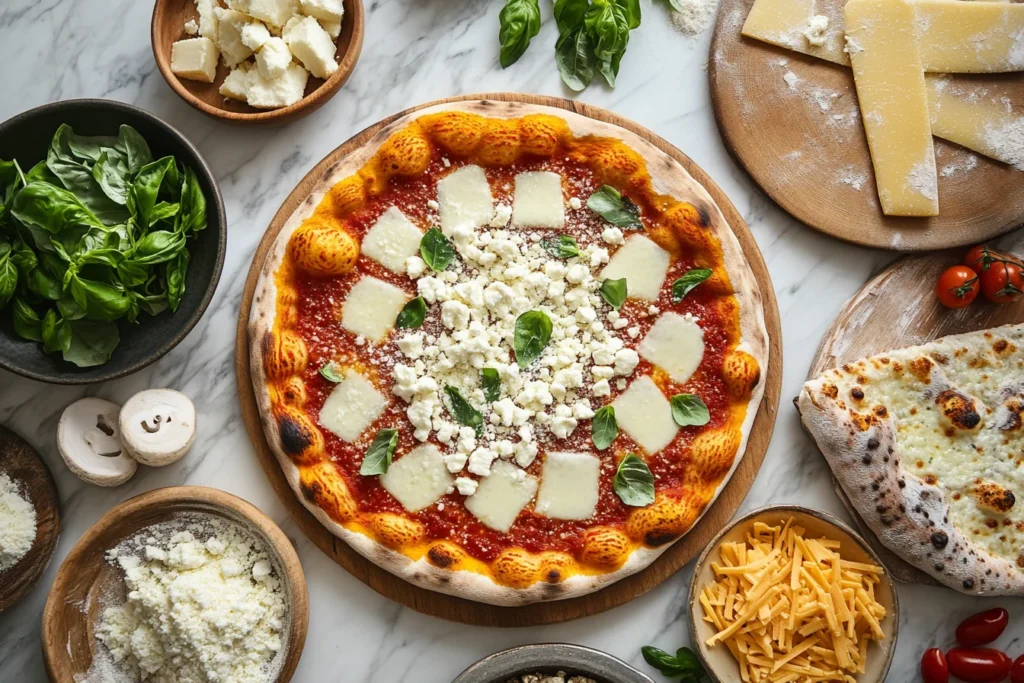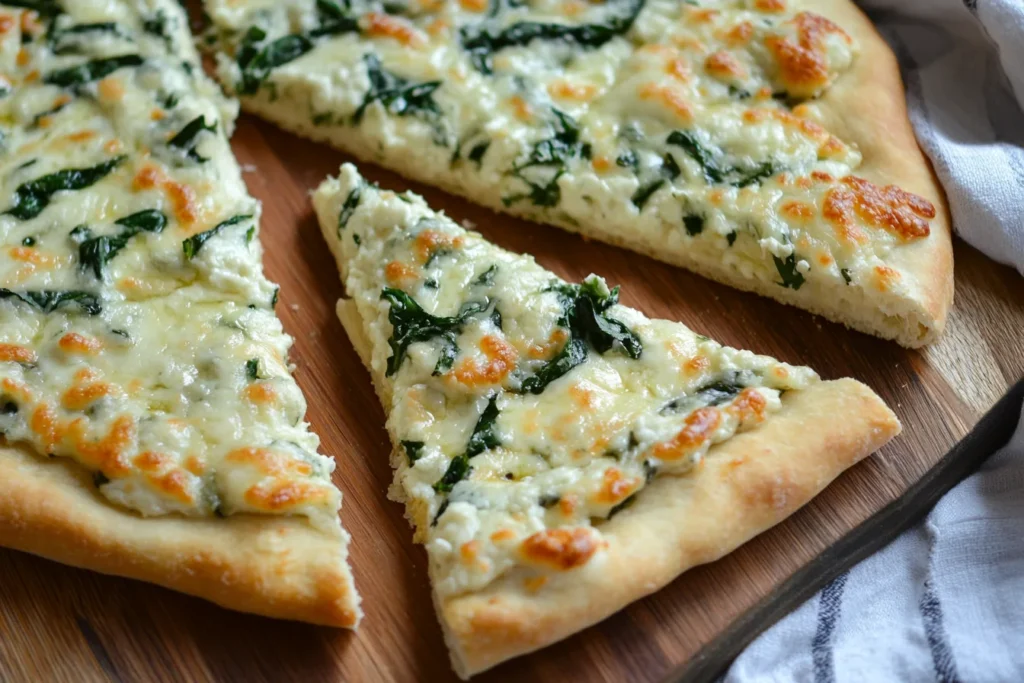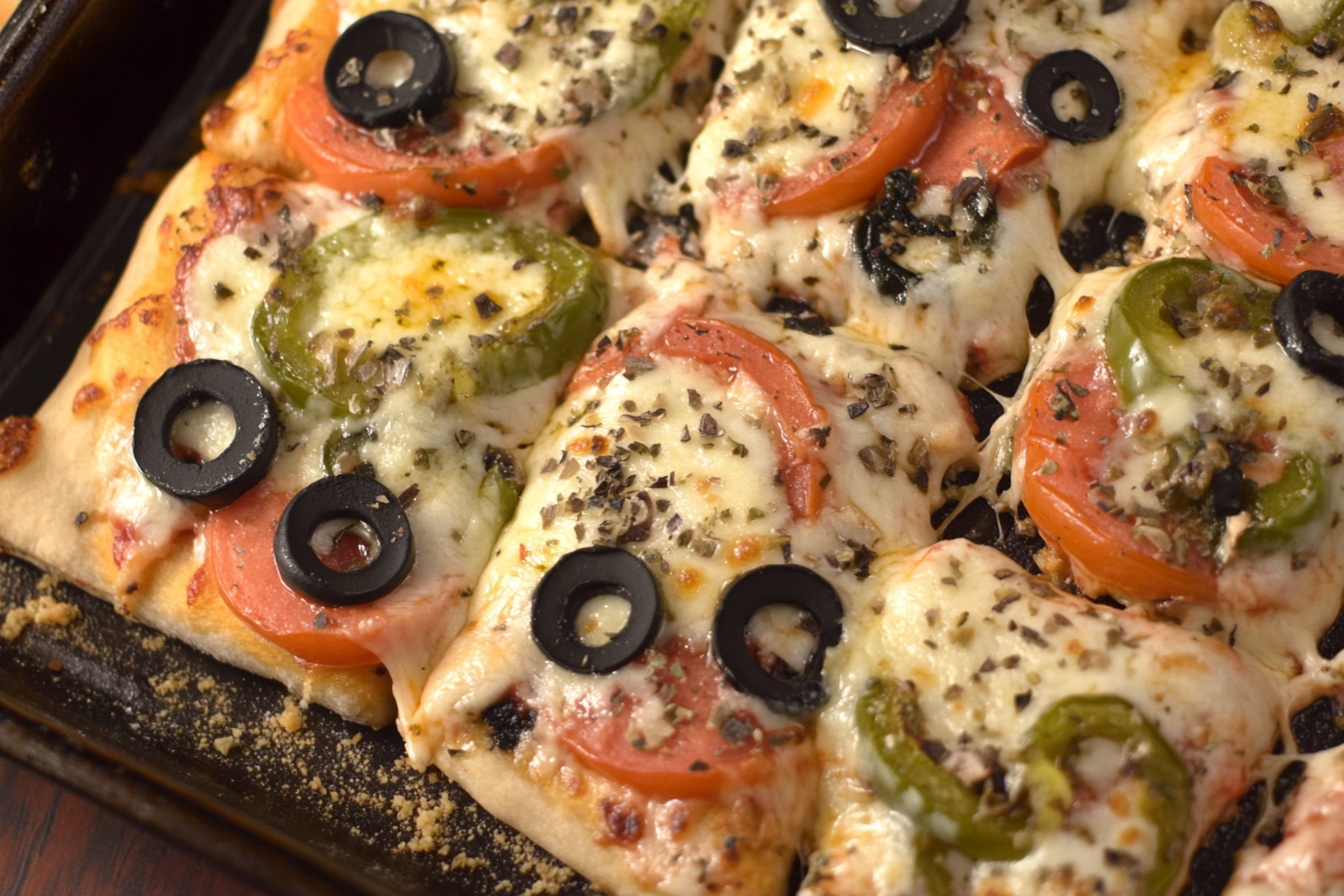Crushing cheese for pizza isn’t just about grating; it’s an art that enhances both the taste and texture of your pizza. Whether you’re a home chef or a seasoned pizzaiolo, understanding the importance of properly prepared cheese can elevate your pizza game to new heights. In this guide, we’ll explore the types of cheese, the tools and techniques for crushing, and how to make sure your cheese is perfectly suited to your pizza style.
Understanding Cheese for Pizza
Types of Cheese Used in Pizza
When it comes to pizza, the cheese you choose sets the foundation for the overall flavor. Some of the most popular pizza-friendly cheeses include:
- Mozzarella: Known for its melting point and stretchiness, mozzarella is the gold standard for pizza cheese. Opt for fresh mozzarella for Neapolitan-style pizzas or low-moisture mozzarella for a New York-style pie.
- Cheddar: Adds a sharp, tangy flavor and pairs well with BBQ or veggie pizzas.
- Parmesan: Commonly used as a topping, Parmesan provides a nutty and salty finish.
- Cheese Blends: Pre-mixed options often combine mozzarella, provolone, and cheddar for a balanced flavor and texture.
Each cheese type offers unique characteristics that can be tailored to different pizza styles.
Characteristics of Pizza Cheese
The ideal pizza cheese should meet the following criteria:
- Melting Point: A cheese that melts evenly ensures there are no dry patches on your pizza.
- Stretchiness: This is what gives you that iconic cheese pull.
- Flavor: Cheese should enhance the toppings without overpowering them.
Tools Needed to Crush Cheese
Crushing cheese effectively starts with having the right tools. Depending on the texture and size you’re aiming for, consider:
- Grater: A box grater works for coarse or fine shredding.
- Food Processor: Best for large batches and consistent results.
- Knife: Ideal for chopping cheese into small cubes or chunks.
- Hands: Useful for breaking down softer cheeses like fresh mozzarella.
Cheese Preparation Basics
To get the best results when crushing cheese, always start with fresh, high-quality cheese. Block cheese is preferred over pre-shredded varieties because:
- Pre-shredded cheese often contains anti-caking agents that affect melting and texture.
- Fresh cheese offers better flavor and consistency.
For example, freezing cheese for 15 minutes before grating can make it easier to handle and ensure a consistent shred.

Importance of Proper Cheese Texture
How Texture Affects Pizza
The texture of your cheese impacts how it melts, stretches, and blends with toppings. Unevenly crushed cheese can result in:
- Clumping during baking.
- Burnt edges or raw centers.
- Difficulty in spreading across the pizza dough.
A finely shredded cheese layer, on the other hand, ensures even melting and coverage.
Storage Tips Before Crushing Cheese
To maintain freshness and improve ease of handling:
- Store cheese in an airtight container.
- Keep cheese chilled until ready to crush. Cold cheese grates more cleanly and prevents clumping.
Why Crushing Cheese is Important
Properly crushed cheese ensures:
- Even Distribution: Prevents the pizza from being overloaded in one area.
- Consistent Melting: Smaller, uniform pieces melt at the same rate, avoiding overcooked spots.
- Enhanced Texture: Creates a smooth, cohesive layer that complements the crust and toppings.
Common Mistakes in Crushing Cheese
Avoid these common pitfalls:
- Using Warm Cheese: Warm cheese is sticky and difficult to crush evenly.
- Overloading a Food Processor: This can lead to uneven chunks.
- Skipping Fresh Cheese: Pre-shredded cheese lacks the stretch and flavor of freshly crushed options.
Choosing the Right Cheese for Your Pizza Style
Each pizza style demands a specific cheese texture:
- Thin Crust Pizza: Opt for finely shredded mozzarella to ensure a light, even layer.
- Deep Dish: Use thick slices or chunks of cheese to complement the hearty crust.
- Neapolitan: Stick with fresh mozzarella for a classic taste.
- New York Style: Go for a combination of low-moisture mozzarella and cheddar for a balanced, flavorful topping.
Techniques to Crush Cheese for Pizza
Perfectly crushed cheese is the cornerstone of a delicious pizza. From hand-grating to advanced tools, mastering the art of crushing cheese ensures your pizza has the ideal texture, melt, and flavor. Here’s a deep dive into techniques and methods to achieve flawless cheese preparation.
Hand Grating Techniques
Best Methods to Grate Cheese Evenly
Hand grating is one of the simplest and most effective ways to crush cheese. Follow these tips for consistent results:
- Use the Right Grater:
- A box grater provides multiple options, from coarse to fine shredding.
- Microplane graters work well for harder cheeses like Parmesan.
- Stabilize Your Workspace:
- Place a damp cloth under your grater to prevent slipping.
- Always use a sturdy cutting board or surface.
- Prepare the Cheese:
- Refrigerate the cheese for at least 15 minutes before grating.
- Larger cheese blocks are easier to grip and shred evenly.
Common Issues with Hand Grating
While hand-grating is straightforward, challenges like clumping and uneven shreds can arise. Combat these by:
- Coating the grater with a light spray of cooking oil to reduce sticking.
- Grating only small amounts at a time to avoid uneven pressure.
Using a Box Grater
Advantages and Best Practices
The box grater is a versatile tool that can handle a range of cheese types. Its benefits include:
- Variety: Offers different grating sizes for coarse or fine textures.
- Simplicity: Requires minimal setup and cleaning.
How to Use a Box Grater Effectively:
- Hold the grater at a 45-degree angle for better leverage.
- Move the cheese in smooth, steady strokes to avoid uneven shreds.
- Collect the grated cheese on a flat surface or directly onto parchment paper.
Crushing Cheese with a Knife
How to Finely Chop Cheese
For certain pizza styles, finely chopped or cubed cheese works better than grated cheese. Use these steps for knife-crushing:
- Start with a Cold Cheese Block:
- Cold cheese is firmer and easier to chop.
- Cut Evenly:
- Slice the cheese into thin sheets first.
- Stack the sheets and cut into small cubes or strips.
- Use the Right Knife:
- A chef’s knife offers better precision and control.
- Keep the blade sharp to prevent crumbling.
This method is perfect for toppings where chunky textures are desirable, such as deep-dish or gourmet pizzas.
Utilizing a Food Processor
Quick and Efficient Cheese Crushing
A food processor is ideal for crushing large batches of cheese quickly and uniformly. Here’s how to use it effectively:
- Pre-Freeze the Cheese:
- Pop the cheese into the freezer for 10–15 minutes to firm it up.
- Choose the Right Blade:
- Use a shredding disc for grated cheese or the standard blade for finer results.
- Process in Small Batches:
- Overloading the processor can lead to inconsistent shreds.
Food processors are particularly helpful when preparing cheese blends or handling harder cheeses.
Freezing Cheese Before Crushing
Benefits and Steps
Freezing cheese for a short time before crushing has several advantages:
- Improved Texture: Prevents sticking and ensures uniform shreds.
- Easier Handling: Makes soft cheeses firmer and easier to grate or chop.
Steps to Freeze Cheese:
- Wrap the cheese in parchment paper or place it in an airtight bag.
- Freeze for 10–20 minutes until firm but not frozen solid.
- Proceed with grating or crushing as needed.
Blending Cheeses During Crushing
Creating Custom Cheese Blends
Blending cheeses during the crushing process allows you to customize flavors and textures. For example:
- Combine mozzarella and cheddar for a stretchy, tangy mix.
- Mix Parmesan with provolone for a nutty, creamy flavor.
Tips for Blending:
- Ensure all cheeses are at the same temperature to prevent clumping.
- Use a food processor to achieve a consistent mix.
Crushing Soft vs. Hard Cheeses
Adjusting Techniques
Soft and hard cheeses require slightly different approaches:
- Soft Cheeses (e.g., Fresh Mozzarella):
- Freeze briefly before handling.
- Use your hands or a knife to break it into small pieces.
- Hard Cheeses (e.g., Parmesan):
- Grate with a microplane or use a food processor.
- Store grated cheese in a cool, dry place to maintain freshness.
Crushing for Different Pizza Types
Each pizza type benefits from specific cheese textures:
- Margherita Pizza:
- Use fresh mozzarella, hand-torn into small chunks.
- Veggie Pizza:
- Opt for a fine shred of mozzarella and a sprinkle of Parmesan for added depth.
- Meat Lover’s Pizza:
- Blend cheddar and mozzarella for a bold, hearty topping.
How to Avoid Cheese Sticking
Sticking cheese can make crushing a frustrating experience. Avoid this by:
- Keeping tools cold during the process.
- Sprinkling a light layer of cornstarch or flour on shredded cheese to prevent clumping.
Adjusting Cheese Size for Texture
The size of the crushed cheese pieces directly impacts the pizza’s final texture:
- Fine Shreds: Best for thin-crust pizzas to ensure quick melting.
- Coarse Shreds or Chunks: Ideal for deep-dish or rustic styles where a robust cheese layer is desired.
By tailoring the size of your cheese shreds, you can enhance the mouthfeel and appearance of your pizza.
Using Crushed Cheese in Pizza
Once your cheese is perfectly crushed, the next step is mastering its application on pizza. Properly using crushed cheese ensures not only even coverage but also the right flavor balance, melt, and texture. In this section, we’ll explore how to distribute cheese evenly, pair it with toppings, manage baking temperatures, and even creatively utilize leftovers.

Evenly Spreading Crushed Cheese
Techniques for Consistent Coverage
Evenly spreading crushed cheese is crucial for a well-balanced pizza. Follow these steps to ensure a uniform layer:
- Start with the Right Base:
- Use a flat, evenly rolled-out pizza dough for consistent application.
- Ensure the dough is dusted with flour or cornmeal to prevent sticking.
- Measure the Cheese:
- For a standard 12-inch pizza, about 6–8 ounces of cheese is sufficient.
- Adjust based on pizza size or personal preference.
- Distribute Cheese Strategically:
- Begin sprinkling from the center, working outward.
- Avoid piling cheese at the edges to prevent overflow during baking.
Pro Tip: Use your hands to gently pat down the cheese layer, ensuring it adheres to the sauce and creates an even melt.
Pairing Cheese with Toppings
Complementing Flavors with Crushed Cheese
The cheese you choose should enhance the toppings without overpowering them. Here are some classic pairing ideas:
- Vegetarian Pizzas:
- Pair mozzarella with feta or goat cheese for a tangy contrast to fresh veggies.
- Meat-Based Pizzas:
- Combine cheddar and mozzarella for a rich, bold flavor that complements pepperoni, sausage, or bacon.
- Seafood Pizzas:
- Use a light blend of mozzarella and Parmesan to complement delicate flavors like shrimp or clams.
Balancing Cheese Ratios
When using multiple types of cheese, consider these ratios for balanced flavor:
- 60% mozzarella for its stretch and mild flavor.
- 30% cheddar or provolone for sharpness and depth.
- 10% Parmesan for a salty, nutty finish.
Baking Temperature and Cheese Melt
How Crushed Cheese Affects Melting
Properly crushed cheese melts more evenly, enhancing the overall texture of your pizza. Key factors to consider include:
- Oven Temperature:
- Bake your pizza at 475°F to 500°F (245°C to 260°C) for optimal cheese melt.
- Higher temperatures prevent overcooking the crust while achieving a golden cheese layer.
- Cheese Placement:
- Place cheese on top of the sauce and beneath certain toppings (like pepperoni) to protect it from burning.
- Observation:
- Watch for bubbling and browning as indicators of perfectly melted cheese.
Storing Crushed Cheese
Preserving Freshness for Later Use
If you’ve prepared more cheese than needed, proper storage is key to maintaining its quality:
- Short-Term Storage:
- Place crushed cheese in an airtight container or resealable plastic bag.
- Store in the refrigerator for up to 5 days.
- Long-Term Storage:
- Freeze crushed cheese in single-use portions to prevent clumping.
- Use within 2–3 months for the best flavor and texture.
Pro Tip: Label the storage container with the cheese type and date to avoid confusion.
Re-Crushing Stored Cheese
How to Refresh Previously Crushed Cheese
Sometimes stored cheese may clump together. Re-crushing helps restore its usability:
- Bring Cheese to Room Temperature:
- Let it sit out for 10–15 minutes to prevent crumbling.
- Break It Apart:
- Use your hands to separate larger chunks before re-grating or processing.
- Reprocess:
- Run the cheese through a grater or food processor for even results.
Presentation Tips for Crushed Cheese
Adding Aesthetic Value
A visually appealing pizza isn’t just about taste. Use these tips to make your pizza stand out:
- Create Patterns:
- Sprinkle cheese in concentric circles or alternate with toppings for an artistic touch.
- Finish with a Cheese Garnish:
- Add freshly grated Parmesan or Pecorino Romano post-bake for a gourmet look.
- Play with Color:
- Use blends like mozzarella and cheddar to create a vibrant topping.
Balancing Cheese Flavor on Pizza
Avoiding Overpowering or Bland Outcomes
Too much cheese can overwhelm the crust and toppings, while too little can leave your pizza dry. Strike the right balance by:
- Using a kitchen scale to measure the exact amount of cheese.
- Layering thinly to ensure all toppings are visible and balanced.
- Adding a final sprinkle of cheese for flavor without excess weight.
Troubleshooting Cheese Issues
Fixing Uneven Melts or Burnt Cheese
Common problems when using crushed cheese can include:
- Uneven Melt:
- Ensure cheese is evenly distributed and at the right temperature before baking.
- Burnt Cheese:
- Cover the pizza with foil during the last few minutes of baking if the cheese begins to overcook.
Dealing with Oiliness
Some cheeses release oil during baking. Combat this by:
- Using low-moisture mozzarella for reduced oil output.
- Blotting excess oil with a paper towel immediately after baking.
Creative Uses of Leftover Crushed Cheese
Dishes to Utilize Extra Cheese
Leftover crushed cheese doesn’t have to go to waste. Use it in:
- Cheesy Breadsticks:
- Mix crushed cheese with herbs and spread over bread dough before baking.
- Macaroni and Cheese:
- Incorporate various cheese types for a rich and creamy dish.
- Cheese Soups:
- Add crushed cheese to soups like broccoli cheddar for enhanced flavor.
- Stuffed Peppers:
- Use leftover cheese as a filling ingredient for baked peppers.
With these strategies, you’re equipped to use crushed cheese in ways that elevate your pizza to the next level.
More FAQs:
1. Can I use pre-shredded cheese for pizza?
Yes, but fresh crushed cheese offers better flavor, melt, and stretch since pre-shredded options often contain anti-caking agents.
2. How do I keep cheese from burning in the oven?
Lower the oven’s top rack or cover the pizza with foil for the final minutes of baking.
3. What cheese is best for stretchy pizza?
Low-moisture mozzarella is ideal for achieving the iconic cheese pull.
4. Should I crush cheese with or without the rind?
Remove the rind, as it doesn’t melt evenly and can alter the texture.
5. Is it okay to mix soft and hard cheeses?
Absolutely! Combining textures enhances flavor and melt consistency.
6. Why does my cheese clump together?
Warm cheese or over-grating can cause clumping. Chill cheese before crushing to avoid this.
7. Can I use frozen cheese directly on pizza?
Thaw frozen cheese first to prevent uneven melting.
8. What’s the best cheese for deep-dish pizza?
Use a mix of mozzarella and cheddar for a hearty, flavorful layer.
9. Should cheese go under or over toppings?
For most pizzas, cheese goes over the sauce but can go under toppings like pepperoni to prevent burning.
10. How do I keep leftover crushed cheese fresh?
Store it in an airtight container or freeze it in portions for later use.

